#vital wheat gluten
Text

Seitan Souvlaki with Roasted Veggies & Tzatziki Sauce (Vegan)
#vegan#street food#greek cuisine#skewers#souvlaki#veganized#diy#seitan#roasted vegetables#bell peppers#zucchini#red onion#dill#vital wheat gluten#tofu#nutritional yeast#sage#thyme#onion powder#garlic powder#vegan yogurt#parsley#garlic#lemon#tomatoes#olive oil#black pepper#flatbread#dips#recipe is removed...but it's still good inspo
363 notes
·
View notes
Text
A Beginner Baker’s Guide to Gluten

Gluten gets a lot of negative attention these days thanks to the dieting industry. Many influencers claim that by eliminating gluten from the foods you eat, you can boost your energy levels and maintain a healthy weight.
But is gluten really that bad? How does gluten actually affect you? And should you remove it from your baking?
Let’s take a closer look at gluten to answer some of the most commonly asked questions by beginning bakers.
What Is Gluten?
Gluten is a catch-all term for storage proteins found in certain grains, specifically wheat, rye, barley, and triticale. These naturally occurring proteins like to stick together, creating a structural network similar to glue. In baking, gluten gives dough its stretchy, elastic texture, and it traps gasses and moisture to give bread its soft, distinctive chew.
What Is Vital Wheat Gluten?
If you’ve browsed some of my recipes, you may have noticed that a few recipes call for high-protein bread flour or a combination of vital wheat gluten and all-purpose flour.
Vital wheat gluten is a powdered form of gluten that many bakers use as an additive to increase flour’s protein content. If you’re making an artisan-style sourdough loaf, the extra gluten can improve your dough’s stability and structure, making it easier to shape.
Is Gluten Bad for You?
The human body uses enzymes to break down consumed proteins such as gluten, though it doesn’t break down gluten completely. For some people, the undigested gluten triggers an autoimmune response when it reaches the small intestine, resulting in unpleasant symptoms such as bloating, diarrhea, headaches, and even rashes.
However, for the rest of us, undigested gluten poses no risk, and gluten itself is a reliable source of protein and fiber. Furthermore, going gluten-free does not guarantee any weight loss benefits on its own. Many gluten-free processed foods rely on starches to hold and stabilize food as a substitute for gluten. These starches can actually raise blood sugar levels and cause weight gain rather than being the advertised cure-all.
Which Flours Have the Most Gluten?

To find out which flours have the most gluten for your baking (as well as which flours are gluten free), read the rest of The Beginner Baker’s Guide to Gluten at BreadbytheHour.com
5 notes
·
View notes
Text
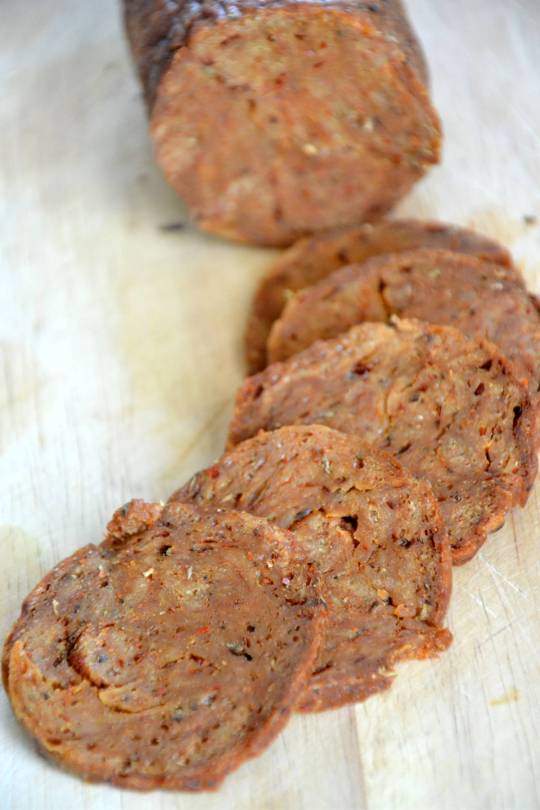

DIY Vegan Pepperoni
1 cup wheat gluten
2 tbsp flour
1 tbsp potato starch
1 tbsp nutritional yeast
1 tbsp dried oregano
1 tbsp dried basil
1 tbsp paprika
1 tsp beet powder
1 tsp red pepper flakes
1 tsp salt
1 cup hot water
1 tbsp veggie bouillon
Get the full, detailed instructions in the link above!
3 notes
·
View notes
Text
youtube
gluten free hvd
#gluten#noodle#noodles#the ramen rater#theramenrater#instant noodles#soup#instant#instantnoodles#food#ramen#gluten familia rica#vital wheat gluten#glutenfri mat#foodfeed#healtyfood#healtyfoodblog#gluten sensitivity#foodbloggersite#foodblogwebsite#gluten allergy#Youtube
1 note
·
View note
Text


Dinner tonight was one of those where I’m sad when it’s gone.
Pasta with sautéed onion, mushroom, and habanero, topped with tomato, olive oil, and parmesan.
Then made a seitan log for the first time in ages. It’s pretty chewy, prob didn’t use enough water and maybe overcooked for a few. Either way, cut into 8 servings — about 135 cals / 26g protein — if you’re into that sorta thing.
#food#kaizen pasta#seitan#vital wheat gluten#vegan pepperoni#vegetarian#vegetarian lifter#vegan food
1 note
·
View note
Text
Low-Carb Bread Machine Bread
Low-carb bread, made in the bread machine. It rises nicely, is big enough for a satisfying sandwich, and doesn’t taste like cardboard. #ThisGirlLovesToEat
One of the biggest complaints I, and others, have about Keto Bread is that it tends to taste too eggy. I’ve been on a mission to eliminate that and discovered that, with my new bread machine, I can bake #KetoFriendly, #EggFree, loaves of bread. Of course, buying a new bread machine means yet another tool I need to find a home for in my #StorageChallengedKitchen. But #ThisGirlLovesToEat, so…

View On WordPress
#Bread Machine Instant Yeast Yeast#Carbalose® Lo-Carb Flour#Cuisinart Convection Breadmaker#Egg Free#Keto Bread Machine White Bread#This Girl Loves To Eat#Vital Wheat Gluten
0 notes
Text
okay instead of complaining further I want to share something useful I've been using lately as I try to work through the food I have before buying new things, this is a site where you can input the ingredients you have and it'll tell you some recipes you can make with it...so good if you're trying to cut back on your spending or you have trouble coming up with meal ideas 👩🏻🍳
#I've been doing my new year declutter and tackling my pantry was so embarrassing bc why did I have 4 nearly empty bags of#vital wheat gluten and 5 boxes of breadcrumbs 🧍🏻♀️#it felt so good to reorganize things so I can more easily see what I have tho. gonna make a list & tape it to the inside of the pantry too
4 notes
·
View notes
Text
got my sponge fermenting in the ovennnnn. bread for dinner night.
#sometimes u just gotta#make a loaf and decide that's food for the day#I was thinking about making some vital wheat gluten too
2 notes
·
View notes
Text

Tabbouleh-Inspired Chickpea Patties (Vegan)
#vegan#lunch#sandwiches#burgers#burger patties#tabbouleh#bulgur#parsley#mint#green onion#red onion#chickpeas#garlic#pumpkin seeds#vital wheat gluten#lemon#black pepper#burger buns#spinach#tomatoes#mustard#vegan mayo
8 notes
·
View notes
Text

[ID: A greyish brown stew presented alongside flatbread, red pepper paste, green peppers, and carrot sticks. End ID]
سماقية / Summagiyya (Gazan stew with chard, chickpea, sumac, and 'lamb')
Summagiyya (سُمَّاقِيَّة; also translitered "sumagiyya", "sumaghiyyeh" or "sumaqiyya") is one of the signature dishes of the Gaza strip, in particular Gaza City. It consists of lamb, chard, and chickpeas in a sumac-infused broth; savor and zest is added by a dagga of dill seeds, garlic, and peppers, and nutty depth by a generous drizzle of red tahina. The resulting stew is thick, earthy, and slodgily grey (due to the green chard and red sumac)—it also has the characteristic sourness of much Gazan cuisine.
Summagiyya is most often prepared during holidays, especially Eid al-Fitr; it's an excellent make-ahead dish for these occasions, since it's even better once its flavors have had time to meld and mellow overnight. It is served cold alongside fresh vegetables, and eaten by using flatbread to scoop up each bite. This recipe provides a spiced seitan recipe to replace the lamb, but you may also use any lamb or beef substitute of your choice.
Today, summagiyya is often prepared with Israeli white tahina, as decades of punitive import laws, taxes, and restrictions have enforced Palestine's status as a consumer, rather than an producer, of food products. Israeli tariffs on, and confiscations of, Palestinian goods have forced those tahina factories that survived to import sesame seeds rather than using locally grown crops, even as they export the best of their product to Israel. The dubbing of foods such as tahina and hummus as culturally "Israeli" cuisine works to hide this exploitative relationship, and cement an Israeli national identity through the subsuming and erasure of Palestinian existence. It is for this reason that Emad Moussa writes that Palestinian cuisine has a role in "protecting against a people's very extinction."
Medical Aid for Palestinians (MAP) has put out an urgent call for donations to provide medical supplies to Palestinian hospitals when supply lines reopen. Also contact your representatives in the USA, UK, and Canada.
Ingredients:
For the soup:
500g (2 large bunches) chard (شلق), diced
80g Levantine sumac berries (Rhus coriaria)
1/2 cup soaked and boiled chickpeas, mostly cooked (40g dry / scant 1/4 cup)
1/4 cup red tahina
1/2 cup (60g) all-purpose flour
1 large yellow onion
1/4 cup olive oil
1 tsp kosher salt
2 cardamom pods (optional)
2 allspice berries (optional)
More olive oil, to fry
Sumac berries can be found in the spice section of a halal grocery store. If you're unable to locate whole berries, pre-ground will do.
For the dagga:
1 1/2 Tbsp dill seeds
5 cloves garlic
1/2 green cubanelle pepper
2-3 dried red chilis (optional)
1/2 tsp black pepper
1/4 tsp cumin
Dill seeds may be found at a halal, south Asian, or speciality European grocery store. They are commonly used in Indian food and as a pickling spice. At a south Asian grocery store they may be labelled soyo, suva, shepu, or savaa.
For the lamb:
1 cup (120g) vital wheat gluten, aka gluten flour
1/2 Tbsp ground sumac
1/2 tsp ground caraway
1 tsp onion powder
1 tsp Palestinian 7-spice
1/2 tsp garlic powder
1/2 tsp sea salt
1/2 tsp ground black pepper
1/2 tsp ground cumin
1/2 tsp ground aniseed
1/2 tsp turnermic
1 tbsp olive oil
1/2 tsp soy sauce
1 tsp miso paste
2 cloves garlic, grated
2 tsp pomegranate molasses
1 Tbsp white or red tahina
About 1/2 cup vegetarian 'beef' stock from concentrate, or vegetable stock
Pomegranate molasses is simply pomegranate juice that has been reduced to a thick consistency. It may be found in the sauces section of a halal grocery store.
Instructions:
For the soup:
1. Soak dried chickpeas in cool water overnight, or in just-boiled water for an hour. Drain and re-cover with water, and boil for 30-45 minutes, until almost fully cooked. Drain and set aside.
2. Simmer sumac seeds in enough water to cover by a couple inches for about an hour, until the water is dark red. Blend the seeds and water together, then strain the mixture through a cheesecloth.
If you're using ground sumac, skip the blending step. Use a cheesecloth or very fine metal sieve (such as one intended for brewing tea) to remove the ground spice from the water.
3. Whisk the flour into the sumac-infused water.
For the lamb:
1. Combine all dry ingredients in a large mixing bowl. Add wet ingredients other than stock and stir briefly. Add enough stock to produce a soft, smooth dough.
2. Knead by hand on a clean surface, or put in a stand mixer with paddle attachment on medium-low, for about 5 minutes. You should see stringy strands begin to form in the dough.
3. Allow to rest, covered, for 5-10 minutes to encourage gluten formation. Knead for another 3 minutes. Do not over-knead.
4. Tear the dough into bite-sized pieces.
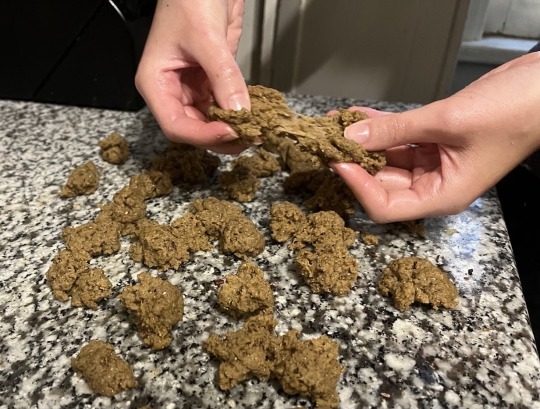
Stringy seitan being pulled apart into pieces.
You may also shape the dough into a slab and cube it with a sharp knife—the lamb or beef used in summagiyya is usually cubed—but I prefer the texture of torn seitan to sliced.
5. Steam the seitan pieces for 10 minutes in a bamboo steamer or using a metal steamer basket. Place the bamboo steamer in the bottom of a wok and cover its base by about 1/2" (1 cm), then raise the heat to boil the water; lower the heat to keep the water at a simmer. If using a steamer basket, place it over the opening of a pot containing a couple inches of water and bring it to a simmer. Start the timer when the water begins simmering.
6. Heat olive oil on medium-high and sear the steamed seitan pieces, turning as necessary, until deeply browned on all sides. Set aside.

Fried seitan pieces.
You can save a step here by searing the raw seitan, then returning it to the pot after you've fried the onions to simmer it rather than steaming. I found that this produced a mushier texture.
For the dagga (دقة):
1. Grind cumin and black pepper thoroughly in a mortar and pestle, then add dried red pepper and dill seed and crush coarsely. Add green sweet pepper and garlic and pound until a coarse mixture forms.
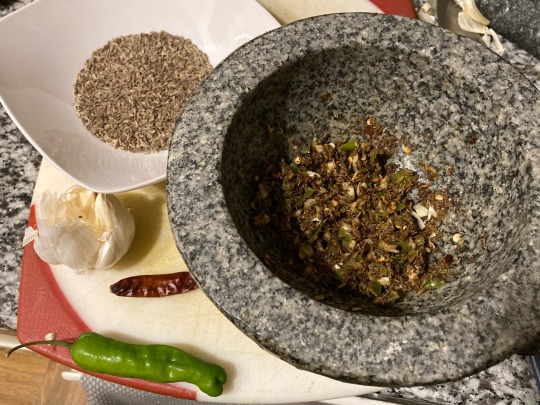
Dill seeds, green sweet pepper, garlic, and dried red chili on a cutting board, alongside dagga in a large granite mortar.
You may also use a spice mill or food processor.
To assemble:
1. Chop the onion. Wash the chard and slice it thinly in one direction; turn it ninety degrees and slice thinly again.
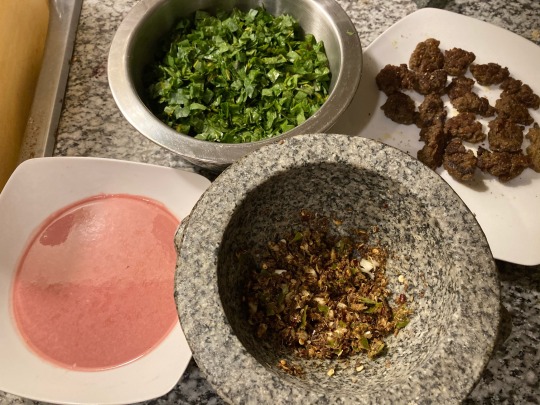
Diced chard, fried seitan, dagga, and sumac-infused water with flour.
2. In a large pot, heat a couple tablespoons of olive oil on medium. Fry chopped onion, cardamom pods, and allspice berries for a minute until fragrant. Add half of the dagga and fry until fragrant.
3. Add chard and fry, mixing often, until wilted.
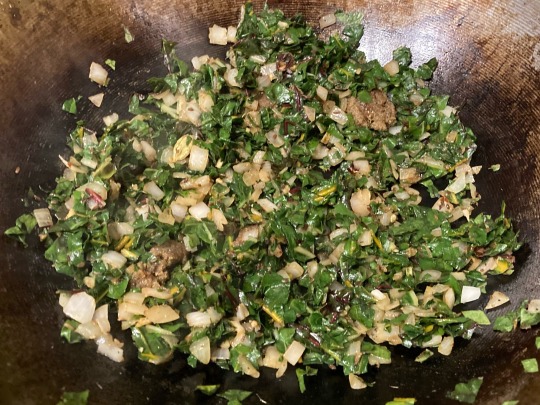
Wilted chard in a wok.
4. Add sumac mixture, chickpeas, and water to cover. Bring to a boil, then lower heat to a simmer. If you didn't steam your seitan earlier, add it now.
5. Continue to stir and simmer until the stew is thick, homogenous, and greyish-brown, about 15 minutes.

Simmered stew.
6. Add the remainder of the garlic mixture, the red tahina, a pinch of ground cumin, the 1/4 cup olive oil, and salt to taste. Return the steamed and seared seitan to the pot and mix.
Serve cool with flatbread, sweet green peppers, bitter green and black olives, carrots, leafy greens, and/or pickles.
#vegetarian recipes#vegan recipe#vegan cooking#Palestinian#Gazan#chickpeas#lamb#seitan#chard#dill seeds#pomegranate molasses
475 notes
·
View notes
Text


Why is my bag of vital wheat gluten flirting with me
28 notes
·
View notes
Note
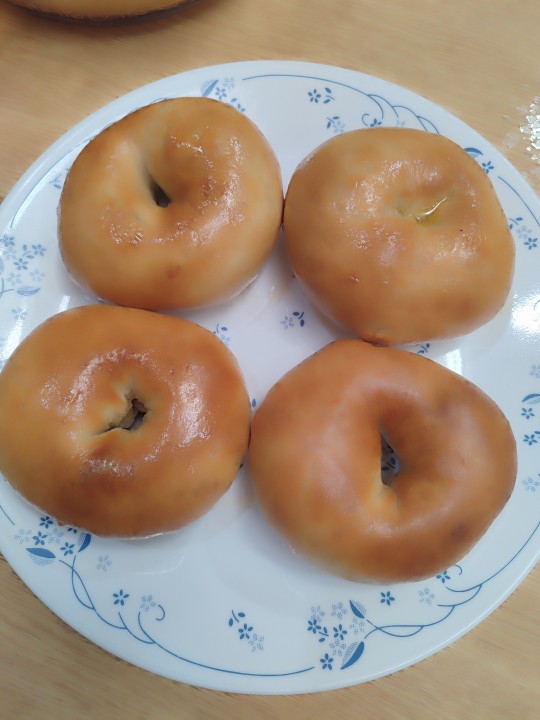
hello princer princezam! I come to offer you bagels I made just the other day.... I must ask if you or anything related to you is gluten intolerant or allergic so I can then adjust with poison or vital wheat gluten accordingly
hello! me personally I am completely immune to both gluten and poison but unfortunately my immune system turns out to be very susceptible to poison! Regardless of that, I’d still very much like a bagel! They look really yummy!! 😋
25 notes
·
View notes
Text
Man I’m really craving some Allspice, amaranth, artichoke, acai Banana, barley, basil, bay leaves, bok choi chai Seitan pot pie, marbled rye, Bedhi'd black eyed peas, bing cherries Chioggia beets, hold the meats, gooseberries Cayenne chestnut, chia, coconut, custard Dahlia dates, saffron, dijon mustard, Durian, curry, kale, kasava Clove, eggplant, flax, demitasse, kava Garlic, kumquat, lychee, oca root Jalapeños, garbanzos, starfruit, snakefruit Lavender, lime, karela, kohlrabi Juniper, jak, wakame, wasabi Papaya, papalo, marigold, mango Oregano, sake, lemon, luo han guo, Kiwi, catnip, carolina reaper Egusi, icaco, Poppies, asparagus, queen anne's carrots Broccoli, a gac, Collard greens, butter beans, vanilla Pomegranate, pineapple, sarsaparilla Rambutan, dragonfruit, tapioca Atemoya, akebia, rose mocha, Amanita muscaria, chive, potatoes Watercress, sprouts, quinoa, tomatoes Parsley, sage, rosemary, Watermelon, marijuana, rhubarb Tamarind, tarragon, turnip, swiss chard Blueberry, caraway, fennel, cacao Boysenberry, cumin, cantaloupe (wow.) Celery, sesame, yam, anise, zinnia Kolas, granolas, marconas, gardenias Lentil, cabbage, vital wheat gluten wiener Ghost pepper, muenster, gewurztraminer, Apple, fig, pear, peach Pine, hazel, walnut, beech Spelt, millet, teff, taro Shallot, ginger, maca, farro, Yarrow, kalendula, kombu, chlorella Cilantro, pecan, citron, portobella Pumpkin, radish, onion, rice Ginkgo, olive, maple, ice, Thyme, strawberry Papaya, cattail, sherry Mulberry, plum, mimosa Argyreia nervosa, Cucumbers, maypops, shamrocks, Bourbon apricot sour Truffle, samphire flower, Squash, zucchini, macaroni, porcini, vermicelli Avocados, pistachios, cinnamon, royal jelly Persimmons, hemp hearts, green goddess Celastrus paniculatus Kombucha and oranges!
100 notes
·
View notes